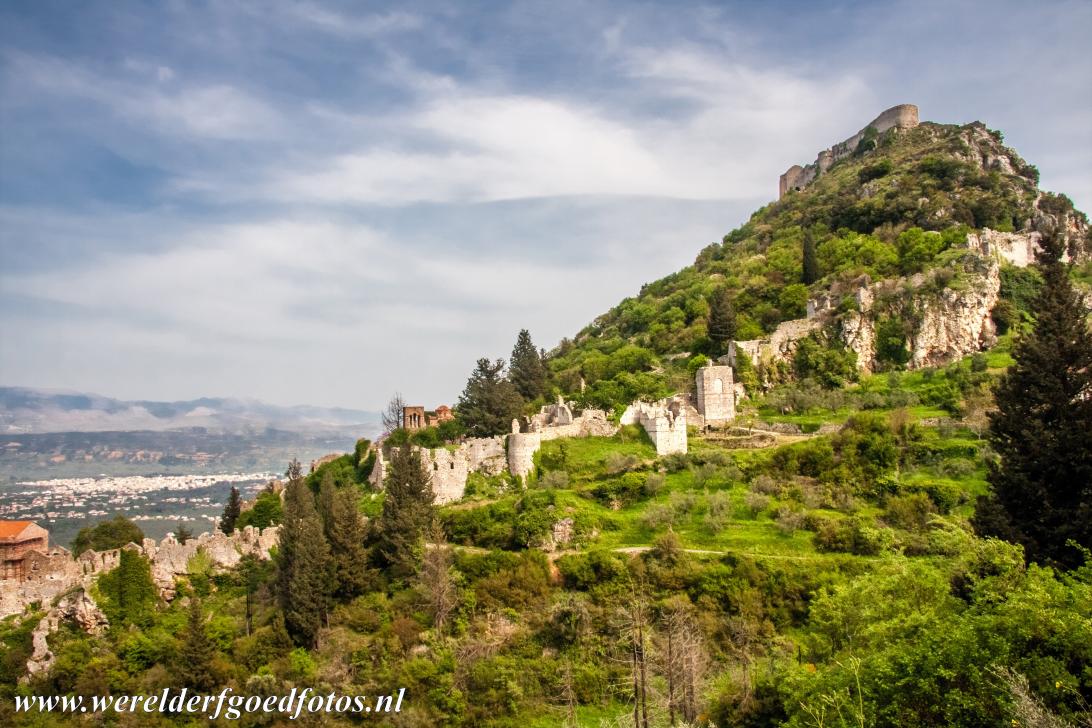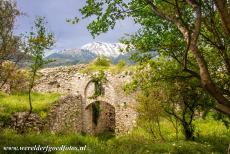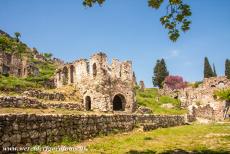Archaeological Site of Mystras: The ancient fortified town of Mystras is situated on the slopes of the Taygetos Mountain, six km northwest of Sparta in Greece. The castle on top of the hill was founded by the Franks in 1249. After 1262, Mystras came under Byzantine rule. In 1448, the last emperor of Byzantium, Constantine XI, was crowned in the Mitrópolis of Mystras in 1448. In the 14th century, Mystras became the seat of the Despotate of Morea. For a short period of time, Mystras came under the control of Venice, but it was taken by the Ottomans, it was one of the first fortifications to be liberated in 1821. The foundation of modern Sparta marked the end of Mystras. Mystras is famous for its churches, some of them reflect the Byzantine style. One of the most important churches of Mystras is the Mitrópolis or the St. Demetrios, the main church of Mystras, where the last Byzantine emperor Constantine XI was crowned. The Agioi Theodoroi is the oldest church in Mystras, it is situated in the Káto Hóra, the Lower Town of Mystras. The architecture of the Agios Theodori resembles to the architecture of the monastery church of Hosios Loukas. The churches of Mystras are adorned with Byzantine frescoes. The Monastery of Pantanassa is the only inhabited monastery in Mystras. Ancient Mystras was already declared an archaeological site in 1922, but people lived in Mystras until 1953. The Archaeological Site of Mystras gained the status as a UNESCO World Heritage in 1989.
www.werelderfgoedfotos.nl © Copyright World Heritage Photos

Archaeological Site of Mystras: The ancient town of Mystras is towering high above the modern towns of Mystras and Sparta. Ancient Mystras was powerful in the Byzantine period. In the last decades of the Byzantine period, it was the second most important town after Constantinople. Nowadays, the ancient Greek town of Mystras is mostly known for its great number of Byzantine churches. The Archaeological Site of Mystras was declared a UNESCO World Heritage in 1989.

Archaeological Site of Mystras: The ancient town of Mystras is towering high above the modern towns of Mystras and Sparta. Ancient Mystras was powerful in the Byzantine period. In the last decades of the Byzantine period, it was the second most important town after Constantinople. Nowadays, the ancient Greek town of Mystras is mostly known for its great number of Byzantine churches. The Archaeological Site of Mystras was declared a UNESCO World Heritage in 1989.

Archaeological Site of Mystras: The Kástro is the fortified castle of Mystras. Mystras was founded by the Franks in 1249. Mystras was built on a steep, rocky hill at the foot of Mount Taygetos. The hill is dotted with churches, monasteries, palaces and houses. In 1262, Mystras became a part of the Byzantine Empire. Mystras was one of the last important Byzantine centres of art, attracting artists from Constantinople and Italy.

Archaeological Site of Mystras: The entrance to the Kástro, the fortress of Mystras. The Kástro of Mystras was built on the top of Mount Taygetos in 1249, the fortress is dominating the plain of Laconia and modern Mystras and Sparta. Ancient Mystras was occupied by the Ottomans and it remained inhabited throughout the Ottoman period. Archaeological Site of Mystras is situated six km northwest of the modern town of Sparta on the Peloponnese in southern Greece.

Archaeological Site of Mystras: The remains of a gate near the Despot's Palace of Mystras. In the 14th century, Mystras became the seat of the Despotate of Morea. The Despots were the rulers of the Peloponnese, which was known as the Morea during the medieval and the early modern period. The court title of Despot was bestowed to the sons or sons-in-law of reigning Byzantine Emperors. The Archaeological Site of Mystras was inscribed on the World Heritage List in 1989.

Archaeological Site of Mystras: The Despot's Palace is loated in the Upper Town of Mystras, Áno Hóra. Only the upper class inhabited the Upper Town of Mystras. Mystras came under Ottoman rule in the 15th century and under the control of the Republic of Venice in 1687. The Ottomans occupied it from 1715 until the beginning of the Greek War of Independence. Mystras was one of the first cities of Greece to be liberated in 1821.

Archaeological Site of Mystras: Moni Pantanassas, the Monastery of Pantanassa, was completed in 1428. The church has five domes, it is one of the best preserved monuments in Mystras. The Monastery of Pantanassa is adorned with frescoes. The Monastery is inhabited by nuns, it is the only permanently inhabited building in Mystras. Services are still held in the church, we had the opportunity to attend a Greek-Orthodox Easter service.

Archaeological Site of Mystras: The Agia Sophia Church in ancient Mystras was named after the patriarchal cathedral in Constantinople. The Agia Sophia Church was built in the 14th century. The Agia Sophia Church has a tower and is decorated with frescoes. The Byzantine church was built for the first Despot of Morea and the noble class of Mystras. The church was used as the chapel of the Despot's Palace of Mystras.

Archaeological Site of Mystras: The Taygetos Mountains seen from Mystras, an ancient fortified town situated on the slopes of the Mount Taygetos, located 6 km north-west of modern Sparta, in the Greek region of Laconia. Mystras became an archaeological site in 1922, but people used to live in Mystras until 1953. The Archaeological Site of Mystras was inscribed on the UNESCO World Heritage List in 1989.

Archaeological Site of Mystras: The Monemvasia Gate was built in the 13th century. The gate is also known as the Sideroporta or Iron Gate. Mystras consists of the Upper Town, the Áno Hóra, and the Lower Town, the Káto Hóra, separated by the Monemvasia Gate. The Upper Town was reserved for the noble people and the Lower Town for the common people.

Archaeological Site of Mystras: The Panagia Odigitria, the Church of Our Lady of Hodegetria. The Monastery of Brontochion houses two Greek-Orthodox churches, the Agioi Theodoroi and the Panagia Odigitria, also known as Aphentiko. The Panagia Odigitria was built in the 14th century, the church has 6 domes and is adorned with frescoes, representing scenes from the Bible such as the 'Wedding in Kana' and the 'Healing of the blind man'.

Archaeological Site of Mystras: The Agioi Theodoroi was completed in 1295. The Agioi Theodoroi is one of the oldest churches in Mystras. The church is adorned with frescoes, which dates back to the 13th century. The church is situated in the Lower Town of Mystras, called the Káto Hóra. The architecture of the Agioi Theodoroi Church resembles to the architecture of the Monastery of Hosios Loukas in the Greek town of Distomo.

Archaeological Site of Mystras: The Byzantine Church of Evangelistria was built at the end of the 14th century and the beginning of the 15th century. The small church most certainly functioned as a funeral church, the domed church was surrounded by graves and ossuaries. The Church of Evangelistria is decorated with frescoes, dating from the late 14th century and the beginning of the 15th century. Mystras is situated on the Peloponnese peninsula in southern Greece.

Archaeological Site of Mystras: The Mitrópolis or the Cathedral of Agios Demetrios is one of the most important churches of Mystras. The Mitrópolis is the oldest church of Mystras, built in the period 1280 -1292. The last Byzantine Emperor Constantine XI was crowned in the Mitrópolis in 1449. Emperor Constantine XI was killed in battle during the fall of Constantinople in 1453, and Mystras and most of the Peloponnese came under Ottoman rule.

Archaeological Site of Mystras: The Monastery Peribleptos, or the Moni Perivleptou, was built in the 14th century. The monastery was partly carved into the side of a rock. The entrance is very small. The domes and walls of the monastery are decorated with frescoes, which dates back to the 13th and 14th centurries. The Byzantine frescoes depict a number of biblical scenes, such as a scene of Saint John the Baptist and a scene of the Baptism of Christ.

Archaeological Site of Mystras: Ancient urban houses in Mystras, people used to live here until 1953. The Byzantine and Archaeological Museum of Mystras is housed in one of the wings of the Mitrópolis. The museum was founded in 1952, it houses objects from the Byzantine period, such as sculptures, pottery, icons and fragments of frescoes. The Archaeological Site of Mystras is situated in the Laconia Region on the Peloponnese in Greece.
